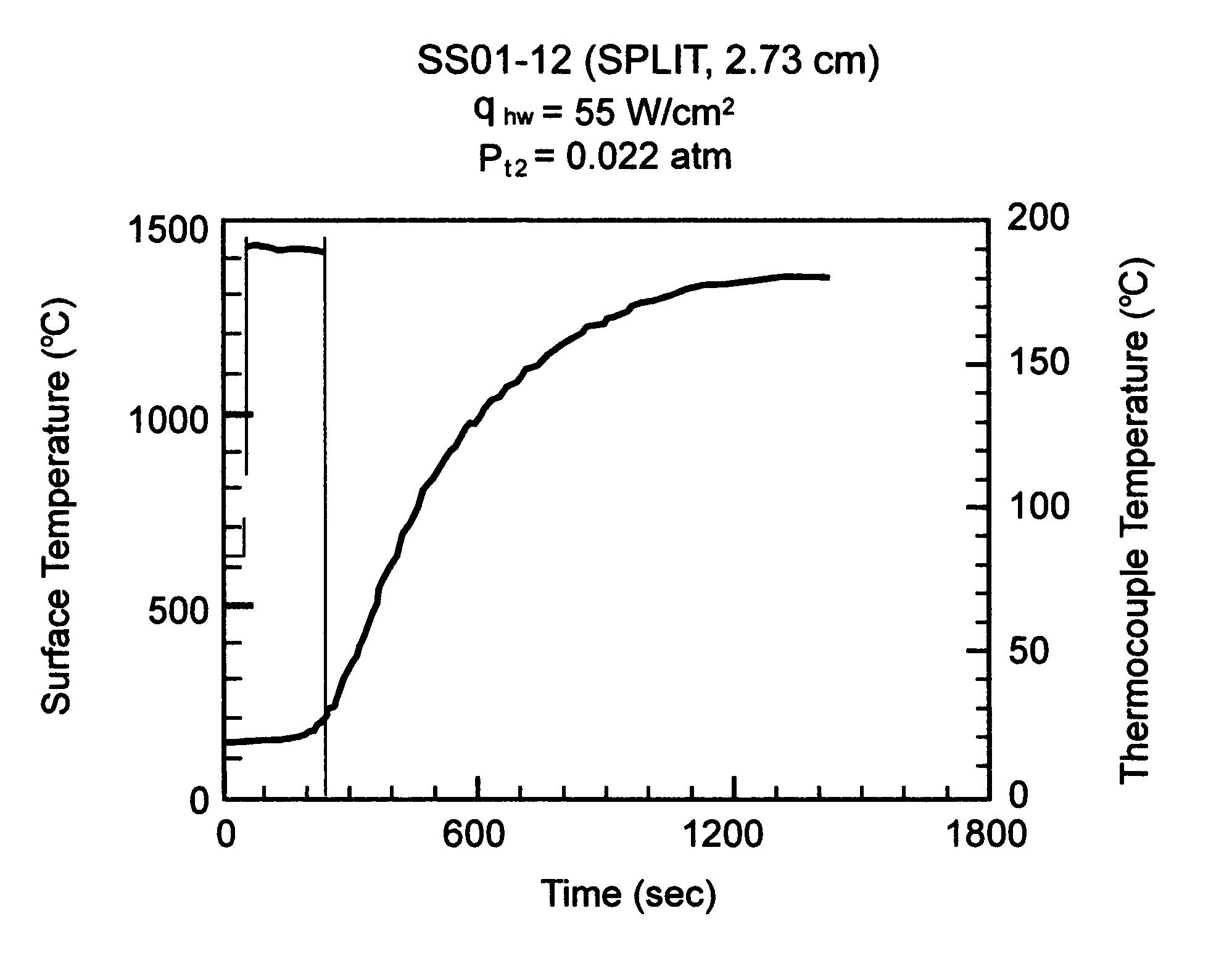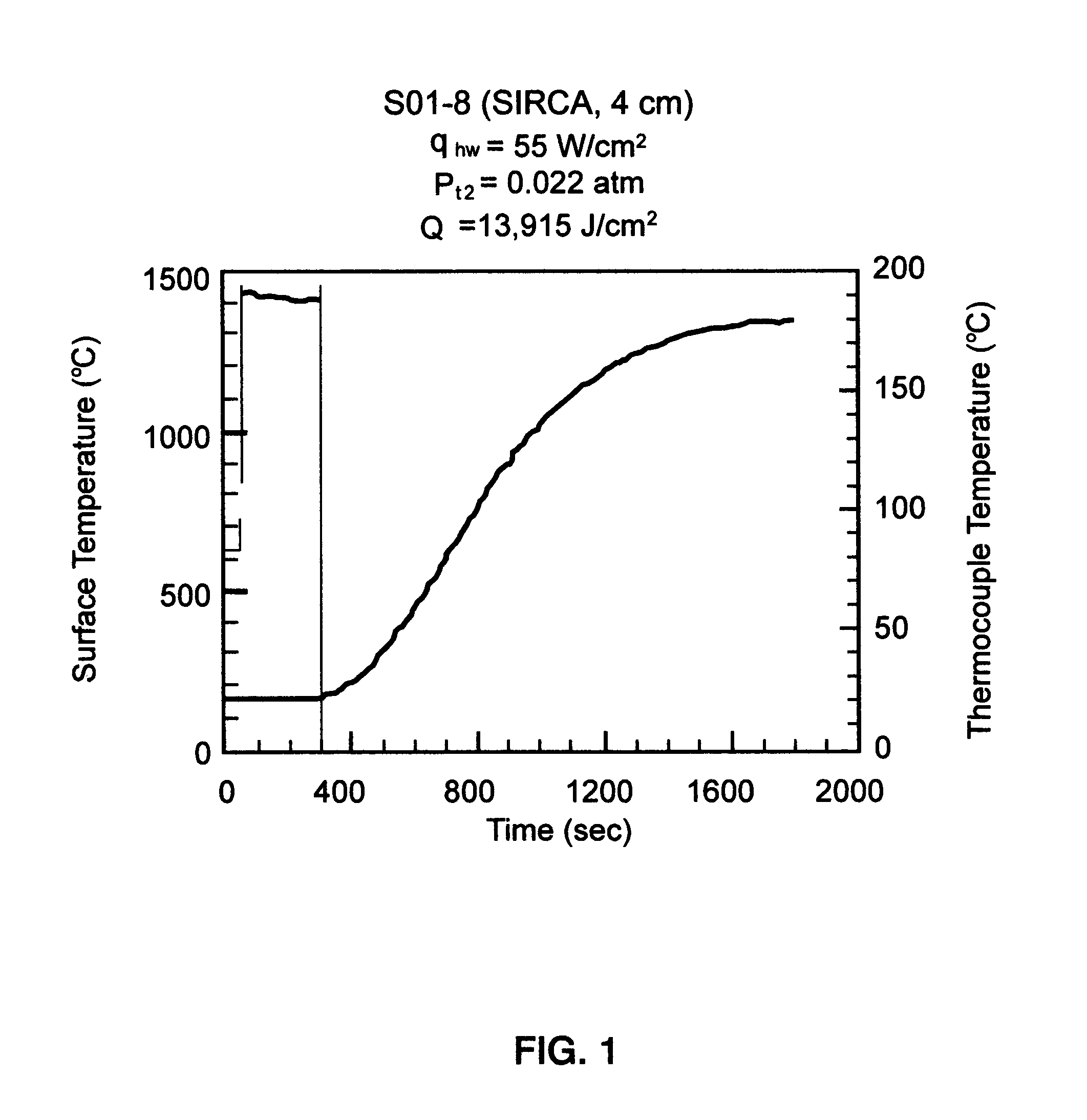Secondary polymer layered impregnated tile
a technology of impregnated tile and polymer layered, which is applied in the field of low density polymeric resin impregnated ceramic articles, can solve the problems of reducing the flexibility of tiles, imposing a large weight penalty, and limiting the weight of scientific payloads, so as to improve the mechanical strength and thermal performance. , the effect of enhancing gas percolation
- Summary
- Abstract
- Description
- Claims
- Application Information
AI Technical Summary
Benefits of technology
Problems solved by technology
Method used
Image
Examples
example 1
[0041]A ceramic article was prepared from a split SIRCA (silicone impregnated reusable ceramic ablator)-PMMA with the PMMA (polymethylmethacrylate) on the bottom of RTV silicone resins using a one-step process. In the one-step process a PMMA solution in ketone (MEK or acetone) or toluene was mixed with RTV 655 (silicone resin) solution in the same solvent. The two polymer solutions will not completely mix to form a homogeneous solution. Instead, a two-layer solution is formed with PMMA on the bottom layer. The location of this boundary line separating the two solutes depends on the amount of the polymers. It is desirable to impregnate more concentrated PMMA near the bottom surface of the SIRCA sample. When a 40% PMMA solution in MEK and a 10% RTV 655 solution in MEK (solvent can also be toluene) are mixed with a volume ratio of 1:9, the boundary line is about ¼ volume from the bottom. A light-weight tile impregnated by the solution containing one part of 40% PMMA and nine parts of 1...
example 2
[0046]In the two-step process, a solution of 30–40% PMMA in MEK (or in toluene) was prepared by dissolving 30–40 g of PMMA (mol. Weight=75000) in 70–60 g of solvent. A calculated amount (depending on the area and the desired depth of the PMMA penetration) of PMMA solution was impregnated on the front surface of the tile. After the solvent evaporated, the rest of the tile (the other side) was impregnated with an RTV 655 solution, then cured and dried. A TGA analyses of the dried sample showed that the bottom surface (0.1″) of the tile was primarily impregnated with PMMA and the rest of the tile was impregnated with RTV 655. An alternative two-step process was to brush the desired amount of PMMA solution on top of SIRCA tiles by brushing the same amount of solvent first. Toluene and alcohol solvents are preferred. If solvent evaporated before the desired amount of PMMA solution is brushed on, more solvent must be applied. Several cornicle cone shaped SIRCAs and split PMMA-SIRCAs were ...
example 3
[0049]When a PMMA solution as used to impregnate the PICA (phenolic impregnated carbon ablators) tile, the solvent (MEK or acetone) evaporated very fact. A PMMA film immediately forms on the surface which prevents further PMMA solution from penetrating into the PICA tile. It evaporates moderately when toluene is used as a solvent. A 30% PMMA (molecular weight of 75000) in toluene is coated on the surface of a PICA tile in about 0.1″ depth, and then dried at room temperature. Several PICA and split PMMA-PICA products were made and subjected to the arc-jet tests.
[0050]FIG. 4 shows the improvement that the PICA / SPLIT material afforded compared to the PICA material. Both materials had the same thickness and were exposed to the same heating environment. FIG. 4 shows the arc-jet data of PICA-15 (mono-polymer impregnation) and PICA / SPLIT at earth entry condition for a comet sample return capsule.
[0051]Two sets of models (one for baseline PICA material and one for PICA / SPLIT material) were ...
PUM
| Property | Measurement | Unit |
|---|---|---|
| width | aaaaa | aaaaa |
| length | aaaaa | aaaaa |
| void volume fraction | aaaaa | aaaaa |
Abstract
Description
Claims
Application Information
 Login to View More
Login to View More - R&D
- Intellectual Property
- Life Sciences
- Materials
- Tech Scout
- Unparalleled Data Quality
- Higher Quality Content
- 60% Fewer Hallucinations
Browse by: Latest US Patents, China's latest patents, Technical Efficacy Thesaurus, Application Domain, Technology Topic, Popular Technical Reports.
© 2025 PatSnap. All rights reserved.Legal|Privacy policy|Modern Slavery Act Transparency Statement|Sitemap|About US| Contact US: help@patsnap.com



